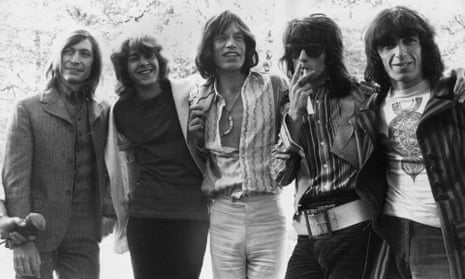The least seen movie about the Rolling Stones ranks as the most revealing one ever made.
Cocksucker Blues, a documentary by photographer Robert Frank which shadowed the band on their pivotal 1972 American tour, has never had a formal release. The Stones made sure of that after seeing Frank’s wilder footage way back when. Luckily, a convoluted deal between the director and the band allows the film to be shown several times a year, with several odd caveats. One dictates that Frank himself must be in attendance. God knows what happens when the 91-year-old director dies.
Two rare screenings will take place this Wednesday and Thursday at the Film Forum in New York. Those who can’t make the date shouldn’t fret. Anyone can find isolated segments of the film on YouTube, adding up to roughly 20 minutes from the full 93. Other snips have turned up here and there, one of the raciest sanctioned by the band themselves. Their 25 X 5 home video contains a group sex scene shot on the Stones’ private plane (with the genitals pixelated out).
Still, it’s not scenes like this which make Cocksucker Blues an artifact worth treasuring. While voyeurs may savor the footage of Keith Richards apparently nodding out on heroin, Mick Jagger snorting a line of cocaine, and a groupie shooting up in a hotel room, it’s actually the most ordinary elements of the film that make eyes go wide.
Most of the footage in the film shows the band and its hangers-on doing nothing more animated than lounging around hotel rooms, smoking cigarettes, casually plunking a piano or staring blankly into space. Essentially, it’s an ambient Stones movie – another likely reason the band shelved it in favor of releasing a more slick, and eventful, documentary of the ’72 tour, titled Ladies and Gentlemen: The Rolling Stones, which was released two years later. So great was the Stones’ charisma and creativity at that time, however, that even the routine moments which dominate Frank’s film are somehow riveting. In fact, it’s their very banality that makes them stand out. When you have as much cool as the Stones did back then, doing nothing is the most transfixing thing of all.
So many decades have passed since the band dulled, it’s hard to remember how cool and outrageous they once were. At the time of the filming, they were touring behind what is arguably their greatest album – Exile on Main Street – with a lineup far more exciting than the one they’ve featured in the years since. The concert footage in Cocksucker Blues captures the most erudite and dexterous lead player they’ve ever had: Mick Taylor. It’s electrifying to hear him let loose in moments like the cocaine-manic section of Midnight Rambler, whose lyrics seem to eroticize murder, capturing the threat of the band in their prime.
The multitudes who see the Stones play Midnight Rambler on their slick and gargantuan tours today experience the song in a very different way – as a vehicle for happy nostalgia and family fun. Today’s Stones so perfectly epitomize the smug classicism of “dad-rock”, it’s downright jaw-dropping to watch them at a time when they made dads fear for their daughters’ virtue, if not their lives.
It’s great, too, to see them looking so beautiful, a quality lost to them by the late 70s. Here, they’re all chiseled cheekbones, tapered torsos, rich shags and pouting lips. It’s the Greek god vision of the 70s rock star.
Of course, the Stones’ particular take on rock stardom pivoted on sleaze, a quality that oozes through every frame of the film. The cherished leer of Cocksucker Blues captures a quality the recent HBO series Vinyl pined for and missed entirely. Its edginess also eclipses another contemporary swipe at a rock star series (Showtime’s Roadies). Both series should have studied the techniques of Cocksucker Blues. With its shaky camera work, blurry image, and muddled sound, it feels more like the work of a peeping tom than a film-maker. It shares that creepy-cool quality with the great cinéma-vérité rock films of the day, from DA Pennebaker’s Dylan doc Don’t Look Back to Albert Maysles’s film on the Stones’ disastrous show at Altamont, Gimme Shelter. Like those works, Cocksucker Blues has a tantalizing hint of the illicit.
If you want far more than just a hint – and who doesn’t? – it’s crucial to check out the song titled Cocksucker Blues, more politely known as Schoolboy Blues. The Stones wrote this raw blues grind in 1970 as a screw-you to their record company, Decca, whose contract the song fulfilled. It’s purposely unreleasable, with lyrics that gleefully embrace oral and anal sex, putting Jagger on the receiving end of the latter. Such a perspective would be shocking coming from an ostensibly heterosexual band today, let alone one from 46 years ago. Even the greatest provocateur of our time, Kanye West, wouldn’t dream of going there. The value in watching Cocksucker Blues today is that it whisks us back to a time when the Stones couldn’t get there fast enough.
- Cocksucker Blues is playing at the Film Forum in New York with Don’t Blink, a documentary about Robert Frank

Comments (…)
Sign in or create your Guardian account to join the discussion